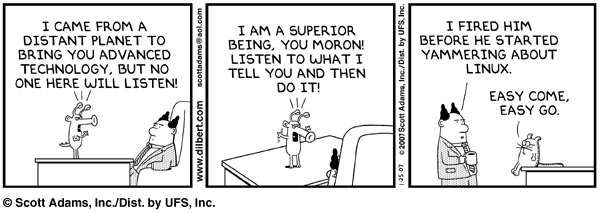So I spent some time over the past couple of days trying to get XFCE4 installed. It is the "other" desktop environment, a distant third behind the GNOME and KDE behemoths, but I was hoping it would run a little better on my machine. I was hoping that it would run in 24bit color mode, mostly, as KDE just hangs as soon as it starts up if I have it in 24bit color.
So I used my usual command to install xfce:
# portmanager x11-wm/xfce -lAnd this worked just fine. But then I noticed the x11-wm/xfce4 port, and saw that it was the "meta-port" that built the entire destkop environment (much like x11/kde3 is the meta-port to install all of KDE). So I tried to do:
# portmanager x11-wm/xfce4 -l
... much output later ...
00001 have:pango-1.14.10 /x11-toolkits/pango built with OLD dependency: xorg-libraries-6.9.0
to no avail, as it kept complaining about the OLD dependency for pango. Now I don't know exactly who is broken, because when I would try to build xorg-libraries, it worked just fine, but I would still get the complaint if I tried to build pango. There's a couple of different portmanager options that should help with this. "-f" is supposed to force building of all dependencies and -pristine is supposed to update a port if all the way down the dependency chain. But if I tried -p, I got:
00001 PRISTINE MODE: pango-1.14.10 /x11-toolkits/pango has incorrect xorg-libraries-6.9.0 entry in +CONTENTS fileSo that didn't work. I tried deleting various packages, rebuilding at different levels, and nothing would work. And portmamanger loops three times if it fails to build something, so if you aren't paying strict attention, it goes through and tries the same thing three times. What's that definition of crazy - "Doing the same thing over and over again expecting different results"? That's what portmanager does. And I couldn't get it to build xfce4, given the state of my machine.
So I went back to doing it the old-fashioned way - with make. cd into /usr/ports/x11-wm/xfce4 and make && make install && make clean. And it worked just fine, thank you very much. I suppose sometimes too much detail can be a killer. And I'm sure portmanager must have some way of telling it to ignore the problem, although the '-ip' option didn't seem to help. And, of course, now I have even more stuff dependent on an old port.
And, after all that, I still don't have a window manager I like:-( I still have the major problem that 'click to focus' doesn't work on any of them. Actually, focus works but it doesn't bring the window to the foreground, which I don't like. So I have to set the option that brings the window under the mouse to the foreground, which is okay in most circumstances, but makes me crazy in a few. I wish I knew why, despite setting the option, the 'click brings to foreground and in keyboard focus' doesn't work. It must have something to do with the mouse, because it doesn't work in all the WMs I've tried. Weird.
